KSZ9031RNX Integrated Triple-speed Transceiver: Equivalent, Pinout and Datasheet
48 Terminations KSZ9031 Receivers 4/4 Drivers/Receivers 1 Functions
The KSZ9031RNX is a completely integrated triple-speed (10BASE-T/100BASE-TX/1000BASE-T) Ethernet physical layer transceiver solution for transmission. Furthermore, Huge range of Semiconductors, Capacitors, Resistors and IcS in stock. Welcome RFQ.
- KSZ9031RNX Pinout
- KSZ9031RNX CAD Model
- Description
- KSZ9031RNX Features
- Specifications
- KSZ9031RNX Functional Block Diagram
- KSZ9031RNX RESET CIRCUIT
- KSZ9031RNX REFERENCE CIRCUITS — LED STRAP-IN PINS
- KSZ9031RNX MAGNETIC — CONNECTION AND SELECTION
- KSZ9031RNX Equivalent
- KSZ9031RNX Application
- KSZ9031RNX Package
- KSZ9031RNX Manufacturer
- Parts with Similar Specs
- Datasheet PDF
- Trend Analysis
KSZ9031RNX Pinout

KSZ9031RNX Pinout
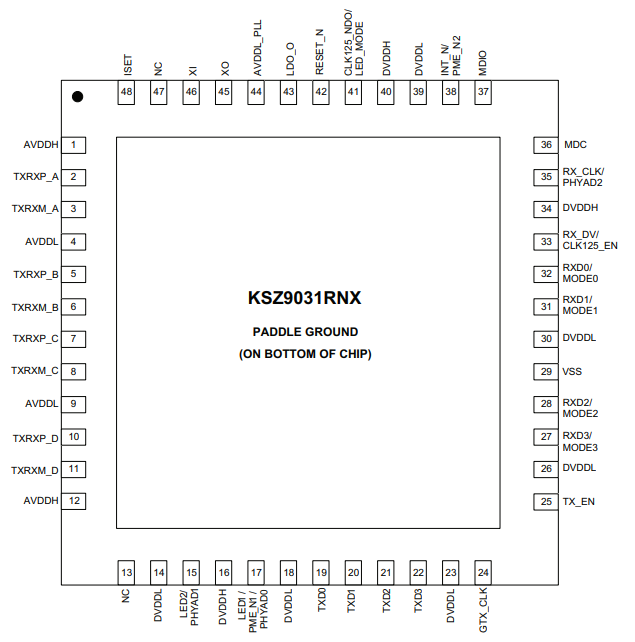
KSZ9031RNX Pin Assignment (TOP VIEW)
KSZ9031RNX CAD Model

Symbol

Footprint
Description
The KSZ9031RNX is a completely integrated triple-speed (10BASE-T/100BASE-TX/1000BASE-T) Ethernet physicallayer transceiver for transmission and reception of data on standard CAT-5 unshielded twisted pair (UTP) cable.
The KSZ9031RNX reduces board cost and simplifies board layout by using on-chip termination resistors for the four differential pairs and by integrating an LDO controller to drive a low-cost MOSFET to supply the 1.2V core. On the copper media interface, the KSZ9031RNX can automatically detect and correct for differential pair misplacements and polarity reversals, and correct propagation delays and re-sync timing between the four differential pairs, as specified in the IEEE 802.3 standard for 1000BASE-T operation.
The KSZ9031RNX offers diagnostic features to facilitate system bring-up and debugging in production testing and in product deployment.
KSZ9031RNX Features
• Single-Chip 10/100/1000 Mbps Ethernet Transceiver Suitable for IEEE 802.3 Applications
• RGMII Timing Supports On-Chip Delay According to RGMII Version 2.0, with Programming Options for External Delay and Making Adjustments and Corrections to TX and RX Timing Paths
• RGMII with 3.3V/2.5V/1.8V Tolerant I/Os
• Auto-Negotiation to Automatically Select the Highest Link-Up Speed (10/100/1000 Mbps) and Duplex (Half/Full)
• On-Chip Termination Resistors for the Differential Pairs
• On-Chip LDO Controller to Support Single 3.3V Supply Operation–Requires Only One External FET to Generate 1.2V for the Core
• Jumbo Frame Support up to 16 KB
• 125 MHz Reference Clock Output
• Energy Detect Power-Down Mode for Reduced Power Consumption When the Cable is Not Attached
• Wake-On-LAN (WOL) Support with Robust Custom-Packet Detection
• Programmable LED Outputs for Link, Activity, and Speed
• Baseline Wander Correction
• LinkMD TDR-Based Cable Diagnostic to Identify Faulty Copper Cabling
• Parametric NAND Tree Support to Detect Faults Between Chip I/Os and Board
• Loopback Modes for Diagnostics
• Automatic MDI/MDI-X Crossover to Detect and Correct Pair Swap at all Speeds of Operation
• Automatic Detection and Correction of Pair Swaps, Pair Skew, and Pair Polarity
• MDC/MDIO Management Interface for PHY Register Configuration
• Interrupt Pin Option
• Power-Down and Power-Saving Modes
• Operating Voltages
- Core (DVDDL, AVDDL, AVDDL_PLL): 1.2V (External FET or Regulator)
- VDD I/O (DVDDH): 3.3V, 2.5V, or 1.8V
- Transceiver (AVDDH): 3.3V or 2.5V (Commercial Temp.)
• AEC-Q100 Grade 3 (KSZ9031RNXUA/UB) and Grade 2 (KSZ9031RNXVA/VB) Qualified for Automotive Applications
• 48-pin QFN (7 mm×7 mm) Package
Specifications
- TypeParameter
- Factory Lead Time1 Weeks
- Mount
In electronic components, the term "Mount" typically refers to the method or process of physically attaching or fixing a component onto a circuit board or other electronic device. This can involve soldering, adhesive bonding, or other techniques to secure the component in place. The mounting process is crucial for ensuring proper electrical connections and mechanical stability within the electronic system. Different components may have specific mounting requirements based on their size, shape, and function, and manufacturers provide guidelines for proper mounting procedures to ensure optimal performance and reliability of the electronic device.
Surface Mount - Mounting Type
The "Mounting Type" in electronic components refers to the method used to attach or connect a component to a circuit board or other substrate, such as through-hole, surface-mount, or panel mount.
Surface Mount - Package / Case
refers to the protective housing that encases an electronic component, providing mechanical support, electrical connections, and thermal management.
48-VFQFN Exposed Pad - Usage LevelIndustrial grade
- Operating Temperature
The operating temperature is the range of ambient temperature within which a power supply, or any other electrical equipment, operate in. This ranges from a minimum operating temperature, to a peak or maximum operating temperature, outside which, the power supply may fail.
-40°C~85°C - Packaging
Semiconductor package is a carrier / shell used to contain and cover one or more semiconductor components or integrated circuits. The material of the shell can be metal, plastic, glass or ceramic.
Tray - Published1996
- JESD-609 Code
The "JESD-609 Code" in electronic components refers to a standardized marking code that indicates the lead-free solder composition and finish of electronic components for compliance with environmental regulations.
e3 - Part Status
Parts can have many statuses as they progress through the configuration, analysis, review, and approval stages.
Active - Moisture Sensitivity Level (MSL)
Moisture Sensitivity Level (MSL) is a standardized rating that indicates the susceptibility of electronic components, particularly semiconductors, to moisture-induced damage during storage and the soldering process, defining the allowable exposure time to ambient conditions before they require special handling or baking to prevent failures
3 (168 Hours) - Number of Terminations48
- TypeTransceiver
- Terminal Finish
Terminal Finish refers to the surface treatment applied to the terminals or leads of electronic components to enhance their performance and longevity. It can improve solderability, corrosion resistance, and overall reliability of the connection in electronic assemblies. Common finishes include nickel, gold, and tin, each possessing distinct properties suitable for various applications. The choice of terminal finish can significantly impact the durability and effectiveness of electronic devices.
Matte Tin (Sn) - annealed - Voltage - Supply
Voltage - Supply refers to the range of voltage levels that an electronic component or circuit is designed to operate with. It indicates the minimum and maximum supply voltage that can be applied for the device to function properly. Providing supply voltages outside this range can lead to malfunction, damage, or reduced performance. This parameter is critical for ensuring compatibility between different components in a circuit.
1.8V 2.5V 3.3V - Terminal Position
In electronic components, the term "Terminal Position" refers to the physical location of the connection points on the component where external electrical connections can be made. These connection points, known as terminals, are typically used to attach wires, leads, or other components to the main body of the electronic component. The terminal position is important for ensuring proper connectivity and functionality of the component within a circuit. It is often specified in technical datasheets or component specifications to help designers and engineers understand how to properly integrate the component into their circuit designs.
QUAD - Terminal Form
Occurring at or forming the end of a series, succession, or the like; closing; concluding.
NO LEAD - Peak Reflow Temperature (Cel)
Peak Reflow Temperature (Cel) is a parameter that specifies the maximum temperature at which an electronic component can be exposed during the reflow soldering process. Reflow soldering is a common method used to attach electronic components to a circuit board. The Peak Reflow Temperature is crucial because it ensures that the component is not damaged or degraded during the soldering process. Exceeding the specified Peak Reflow Temperature can lead to issues such as component failure, reduced performance, or even permanent damage to the component. It is important for manufacturers and assemblers to adhere to the recommended Peak Reflow Temperature to ensure the reliability and functionality of the electronic components.
260 - Number of Functions1
- Supply Voltage
Supply voltage refers to the electrical potential difference provided to an electronic component or circuit. It is crucial for the proper operation of devices, as it powers their functions and determines performance characteristics. The supply voltage must be within specified limits to ensure reliability and prevent damage to components. Different electronic devices have specific supply voltage requirements, which can vary widely depending on their design and intended application.
1.2V - Terminal Pitch
The center distance from one pole to the next.
0.5mm - Time@Peak Reflow Temperature-Max (s)
Time@Peak Reflow Temperature-Max (s) refers to the maximum duration that an electronic component can be exposed to the peak reflow temperature during the soldering process, which is crucial for ensuring reliable solder joint formation without damaging the component.
30 - Base Part Number
The "Base Part Number" (BPN) in electronic components serves a similar purpose to the "Base Product Number." It refers to the primary identifier for a component that captures the essential characteristics shared by a group of similar components. The BPN provides a fundamental way to reference a family or series of components without specifying all the variations and specific details.
KSZ9031 - JESD-30 Code
JESD-30 Code refers to a standardized descriptive designation system established by JEDEC for semiconductor-device packages. This system provides a systematic method for generating designators that convey essential information about the package's physical characteristics, such as size and shape, which aids in component identification and selection. By using JESD-30 codes, manufacturers and engineers can ensure consistency and clarity in the specification of semiconductor packages across various applications and industries.
S-XQCC-N48 - Number of Channels1
- Data Rate
Data Rate is defined as the amount of data transmitted during a specified time period over a network. It is the speed at which data is transferred from one device to another or between a peripheral device and the computer. It is generally measured in Mega bits per second(Mbps) or Mega bytes per second(MBps).
1 Gbps - Protocol
In electronic components, the parameter "Protocol" refers to a set of rules and standards that govern the communication between devices. It defines the format, timing, sequencing, and error checking methods for data exchange between different components or systems. Protocols ensure that devices can understand and interpret data correctly, enabling them to communicate effectively with each other. Common examples of protocols in electronics include USB, Ethernet, SPI, I2C, and Bluetooth, each with its own specifications for data transmission. Understanding and adhering to protocols is essential for ensuring compatibility and reliable communication between electronic devices.
Ethernet - Number of Drivers/Receivers4/4
- Duplex
In the context of electronic components, "Duplex" refers to a type of communication system that allows for bidirectional data flow. It enables two devices to communicate with each other simultaneously, allowing for both sending and receiving of data at the same time. Duplex communication can be further categorized into two types: half-duplex, where data can be transmitted in both directions but not at the same time, and full-duplex, where data can be sent and received simultaneously. This parameter is crucial in networking and telecommunications systems to ensure efficient and effective data transmission between devices.
Full - Simplex/Duplex
In electronic components, the parameter "Simplex/Duplex" refers to the type of communication or data transmission mode supported by the component. Simplex communication is a one-way communication mode where data flows only in one direction, from the sender to the receiver. This means that the sender can only transmit data, and the receiver can only receive data. On the other hand, duplex communication is a two-way communication mode where data can flow in both directions, allowing for simultaneous transmission and reception of data between two devices. Understanding whether a component supports simplex or duplex communication is important for determining how data will be exchanged between devices and ensuring compatibility in a given system.
Full Duplex - Max Junction Temperature (Tj)
Max Junction Temperature (Tj) refers to the maximum allowable temperature at the junction of a semiconductor device, such as a transistor or integrated circuit. It is a critical parameter that influences the performance, reliability, and lifespan of the component. Exceeding this temperature can lead to thermal runaway, breakdown, or permanent damage to the device. Proper thermal management is essential to ensure the junction temperature remains within safe operating limits during device operation.
125°C - Ambient Temperature Range High
This varies from person to person, but it is somewhere between 68 and 77 degrees F on average. The temperature setting that is comfortable for an individual may fluctuate with humidity and outside temperature as well. The temperature of an air conditioned room can also be considered ambient temperature.
85°C - Height900μm
- Length7mm
- Width7mm
- RoHS Status
RoHS means “Restriction of Certain Hazardous Substances” in the “Hazardous Substances Directive” in electrical and electronic equipment.
ROHS3 Compliant - Lead Free
Lead Free is a term used to describe electronic components that do not contain lead as part of their composition. Lead is a toxic material that can have harmful effects on human health and the environment, so the electronics industry has been moving towards lead-free components to reduce these risks. Lead-free components are typically made using alternative materials such as silver, copper, and tin. Manufacturers must comply with regulations such as the Restriction of Hazardous Substances (RoHS) directive to ensure that their products are lead-free and environmentally friendly.
Lead Free
KSZ9031RNX Functional Block Diagram

System Block Diagram

KSZ9031RNX Block Diagram
KSZ9031RNX RESET CIRCUIT

RESET CIRCUIT WITH MIC826 VOLTAGE SUPERVISOR
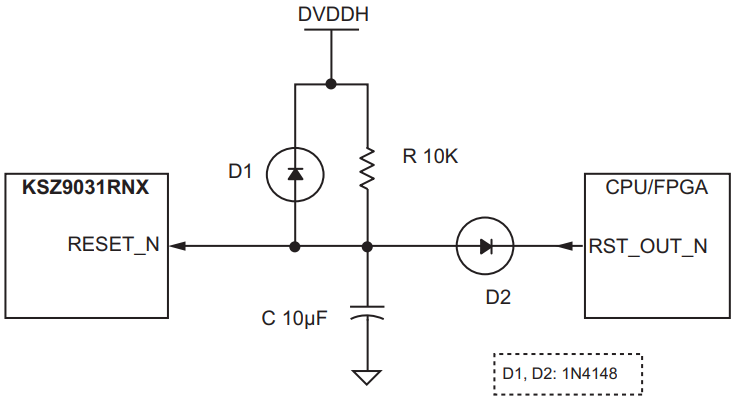
RECOMMENDED RESET CIRCUIT FOR CPU OR FPGA RESET OUTPUT
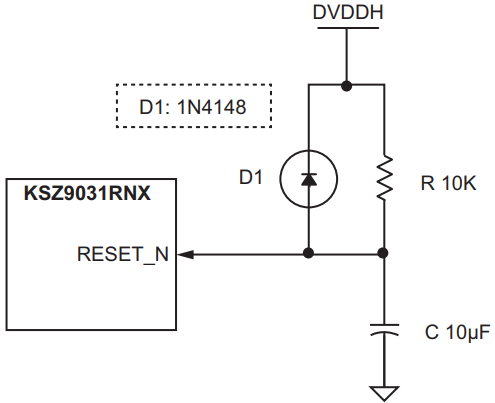
RESET CIRCUIT IF TRIGGERED BY THE POWER SUPPLY
KSZ9031RNX REFERENCE CIRCUITS — LED STRAP-IN PINS

REFERENCE CIRCUITS FOR LED STRAPPING PINS
KSZ9031RNX MAGNETIC — CONNECTION AND SELECTION
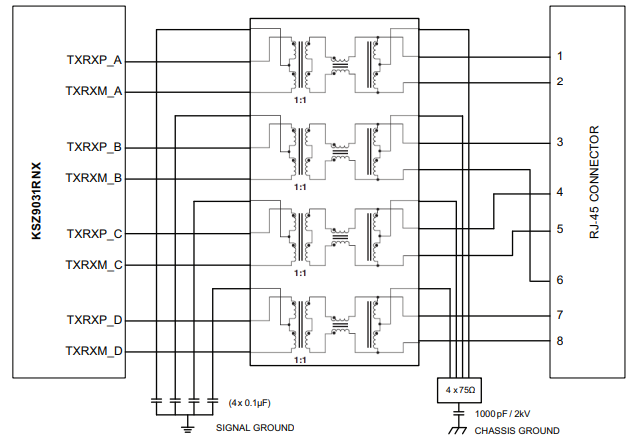
TYPICAL GIGABIT MAGNETIC INTERFACE CIRCUIT

MAGNETICS SELECTION CRITERIA

COMPATIBLE SINGLE-PORT 10 or 100 or 1000 MAGNETICS

COMPATIBLE SINGLE-PORT 10 or 100 or 1000 MAGNETICS
KSZ9031RNX Equivalent
| Model number | Manufacturer | Description |
| KSZ8895RQ | Microchip Technology Inc | Ethernet Transceiver, CMOS, PQFP128, LEAD FREE, PLASTIC, QFP-128 |
| AQR107-B0-EG-Y | Marvell Technology Group Ltd | Ethernet Transceiver, CMOS, PBGA104, FCCSP-104 |
| KSZ9893RNXI | Microchip Technology Inc | Ethernet Transceiver |
| KSZ8864CNXIA-TR | Microchip Technology Inc | DATACOM, ETHERNET TRANSCEIVER, QCC64 |
| KSZ9031RNXUB-TRVAO | Microchip Technology Inc | Ethernet Transceiver |
| 88E3016-A2-NNC1C000 | Marvell Technology Group Ltd | Ethernet Transceiver, CMOS, 9 X 9 MM, ROHS COMPLIANT, QFN-64 |
| KSZ9031RNXCA-TR | Microchip Technology Inc | DATACOM, ETHERNET TRANSCEIVER, QCC48 |
| LAN9354T/ML | Microchip Technology Inc | DATACOM, ETHERNET TRANSCEIVER |
| KSZ9031RNXCA | Microchip Technology Inc | DATACOM, ETHERNET TRANSCEIVER |
| KSZ8563RNXI | Microchip Technology Inc | Ethernet Transceiver, PQCC64 |
KSZ9031RNX Application
• Laser/Network Printer
• Network Attached Storage (NAS)
• Network Server
• Gigabit LAN on Motherboard (GLOM)
• Broadband Gateway
• Gigabit SOHO/SMB Router
• IPTV
• IP Set-Top Box
• Game Console
• Triple-Play (Data, Voice, Video) Media Center
• Industrial Control
• Automotive In-Vehicle Networking
KSZ9031RNX Package
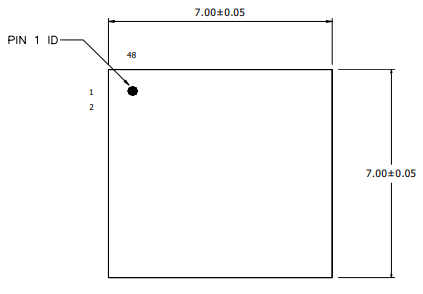
Top view
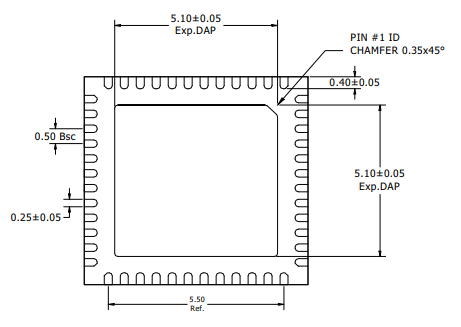
Bottom view
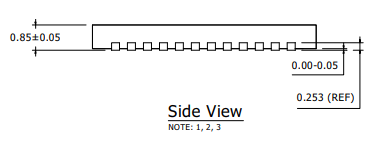
Side view
KSZ9031RNX Manufacturer
Microchip Technology Inc., is a leader that provides microcontroller and analog semiconductors. Microchip was headquartered in Chandler, Arizona. We are delicated to offering low-risk product development, reducing total system cost and accelerating time to market. We mainly serve for different fields of customers applications around the world. To provide prominent technical support along with reliable delivery and quality is our goal.
Parts with Similar Specs
Datasheet PDF
- PCN Assembly/Origin :
- PCN Design/Specification :
- PCN Packaging :
- ConflictMineralStatement :
- Datasheets :
Trend Analysis
What is the definition of the KSZ9031RNX?
The KSZ9031RNX is a completely integrated triple-speed Ethernet physicallayer transceiver for transmission and reception of data on standard CAT-5 unshielded twisted pair (UTP) cable.
Whether the KSZ9031RNX complies with the auto-negotiation protocol?
The KSZ9031RNX conforms to the auto-negotiation protocol, defined in Clause 28 of the IEEE 802.3 Specification. Auto-negotiation allows UTP (unshielded twisted pair) link partners to select the highest common mode of operation.
Whether the KSZ9031RNX supports the IEEE 802.3 MII management interface?
The KSZ9031RNX supports the IEEE 802.3 MII management interface, also known as the Management Data Input/Output (MDIO) interface. This interface allows upper-layer devices to monitor and control the state of the KSZ9031RNX.
![PC817 Optoisolators Transistor Photovoltaic 4DIP[Video]: Pinout, Datasheet, and Equivalents](https://res.utmel.com/Images/Article/c21d5d4a-7f97-47d9-a2df-3305ccf27127.jpg) PC817 Optoisolators Transistor Photovoltaic 4DIP[Video]: Pinout, Datasheet, and Equivalents
PC817 Optoisolators Transistor Photovoltaic 4DIP[Video]: Pinout, Datasheet, and Equivalents24 March 20223511
 AD8226 Instrumentation Amplifier: Rail-to-Rail Output, 8SOIC AD8226 Pinout and Datasheet
AD8226 Instrumentation Amplifier: Rail-to-Rail Output, 8SOIC AD8226 Pinout and Datasheet13 January 20223030
 PCF8591 A/D and D/A Converter: Datasheet, PCF8591 Raspberry Pi, Interfacing
PCF8591 A/D and D/A Converter: Datasheet, PCF8591 Raspberry Pi, Interfacing09 October 20213477
 BC107 Transistor: Pinout, Equivalent and Datasheet
BC107 Transistor: Pinout, Equivalent and Datasheet17 September 202125418
 Microchip PIC18F43K22EPT Microcontroller Datasheet Overview
Microchip PIC18F43K22EPT Microcontroller Datasheet Overview29 February 202458
 L293DD Channel Driver: Pinout, Datasheet and Features
L293DD Channel Driver: Pinout, Datasheet and Features27 July 20213200
 ATTINY85-20SU Microcontroller: Circuit, Pinout, and Datasheet
ATTINY85-20SU Microcontroller: Circuit, Pinout, and Datasheet21 February 20224200
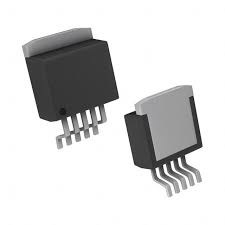 LM2941S Voltage Regulator: Pinout, Specification, and Datasheet
LM2941S Voltage Regulator: Pinout, Specification, and Datasheet23 June 20213520
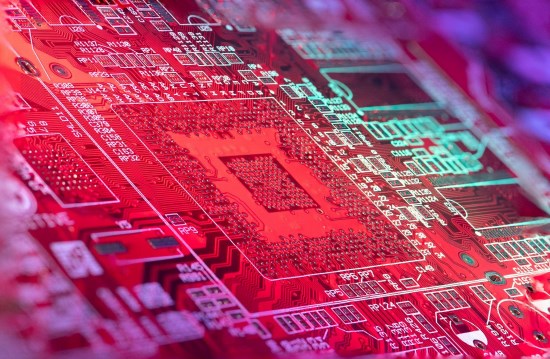 Analyzing the Latest Electronic Components Trends and Their Functions 2023 – 2024
Analyzing the Latest Electronic Components Trends and Their Functions 2023 – 202421 July 20252691
 What is an Accelerometer: Definition, Types and Applications
What is an Accelerometer: Definition, Types and Applications02 April 20229092
 Working Principle and Types of Throttle Position Sensor
Working Principle and Types of Throttle Position Sensor01 April 202431497
 Clock&Timing - Application Specific: A Dedicated Chip That Helps Produce Signals on the Circuit Board
Clock&Timing - Application Specific: A Dedicated Chip That Helps Produce Signals on the Circuit Board22 February 2023758
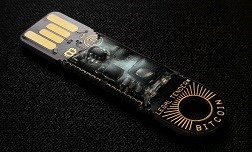 What is a Great Choice for Digital Isolators to Build Isolation Barriers?
What is a Great Choice for Digital Isolators to Build Isolation Barriers?31 March 20223208
 Clamp Diodes: Principles, Functions, and Applications
Clamp Diodes: Principles, Functions, and Applications27 October 202048076
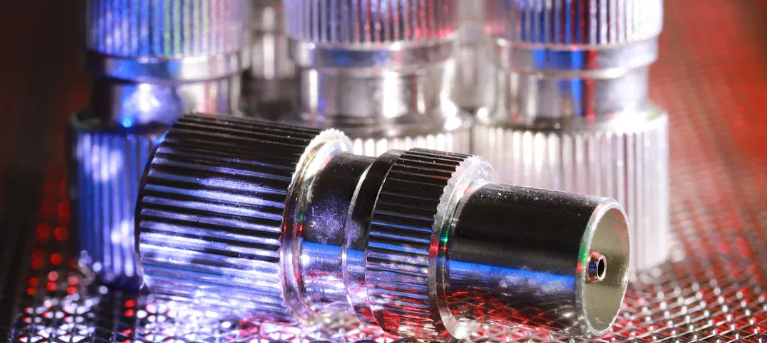 The Historical Milestones of Coaxial Cable Development
The Historical Milestones of Coaxial Cable Development19 July 20251115
 MEMS Announces First Six-Axis IMU-Enabled Somatosensory Interactive System
MEMS Announces First Six-Axis IMU-Enabled Somatosensory Interactive System25 August 20221793
Microchip Technology
In Stock: 220
United States
China
Canada
Japan
Russia
Germany
United Kingdom
Singapore
Italy
Hong Kong(China)
Taiwan(China)
France
Korea
Mexico
Netherlands
Malaysia
Austria
Spain
Switzerland
Poland
Thailand
Vietnam
India
United Arab Emirates
Afghanistan
Åland Islands
Albania
Algeria
American Samoa
Andorra
Angola
Anguilla
Antigua & Barbuda
Argentina
Armenia
Aruba
Australia
Azerbaijan
Bahamas
Bahrain
Bangladesh
Barbados
Belarus
Belgium
Belize
Benin
Bermuda
Bhutan
Bolivia
Bonaire, Sint Eustatius and Saba
Bosnia & Herzegovina
Botswana
Brazil
British Indian Ocean Territory
British Virgin Islands
Brunei
Bulgaria
Burkina Faso
Burundi
Cabo Verde
Cambodia
Cameroon
Cayman Islands
Central African Republic
Chad
Chile
Christmas Island
Cocos (Keeling) Islands
Colombia
Comoros
Congo
Congo (DRC)
Cook Islands
Costa Rica
Côte d’Ivoire
Croatia
Cuba
Curaçao
Cyprus
Czechia
Denmark
Djibouti
Dominica
Dominican Republic
Ecuador
Egypt
El Salvador
Equatorial Guinea
Eritrea
Estonia
Eswatini
Ethiopia
Falkland Islands
Faroe Islands
Fiji
Finland
French Guiana
French Polynesia
Gabon
Gambia
Georgia
Ghana
Gibraltar
Greece
Greenland
Grenada
Guadeloupe
Guam
Guatemala
Guernsey
Guinea
Guinea-Bissau
Guyana
Haiti
Honduras
Hungary
Iceland
Indonesia
Iran
Iraq
Ireland
Isle of Man
Israel
Jamaica
Jersey
Jordan
Kazakhstan
Kenya
Kiribati
Kosovo
Kuwait
Kyrgyzstan
Laos
Latvia
Lebanon
Lesotho
Liberia
Libya
Liechtenstein
Lithuania
Luxembourg
Macao(China)
Madagascar
Malawi
Maldives
Mali
Malta
Marshall Islands
Martinique
Mauritania
Mauritius
Mayotte
Micronesia
Moldova
Monaco
Mongolia
Montenegro
Montserrat
Morocco
Mozambique
Myanmar
Namibia
Nauru
Nepal
New Caledonia
New Zealand
Nicaragua
Niger
Nigeria
Niue
Norfolk Island
North Korea
North Macedonia
Northern Mariana Islands
Norway
Oman
Pakistan
Palau
Palestinian Authority
Panama
Papua New Guinea
Paraguay
Peru
Philippines
Pitcairn Islands
Portugal
Puerto Rico
Qatar
Réunion
Romania
Rwanda
Samoa
San Marino
São Tomé & Príncipe
Saudi Arabia
Senegal
Serbia
Seychelles
Sierra Leone
Sint Maarten
Slovakia
Slovenia
Solomon Islands
Somalia
South Africa
South Sudan
Sri Lanka
St Helena, Ascension, Tristan da Cunha
St. Barthélemy
St. Kitts & Nevis
St. Lucia
St. Martin
St. Pierre & Miquelon
St. Vincent & Grenadines
Sudan
Suriname
Svalbard & Jan Mayen
Sweden
Syria
Tajikistan
Tanzania
Timor-Leste
Togo
Tokelau
Tonga
Trinidad & Tobago
Tunisia
Turkey
Turkmenistan
Turks & Caicos Islands
Tuvalu
U.S. Outlying Islands
U.S. Virgin Islands
Uganda
Ukraine
Uruguay
Uzbekistan
Vanuatu
Vatican City
Venezuela
Wallis & Futuna
Yemen
Zambia
Zimbabwe
















